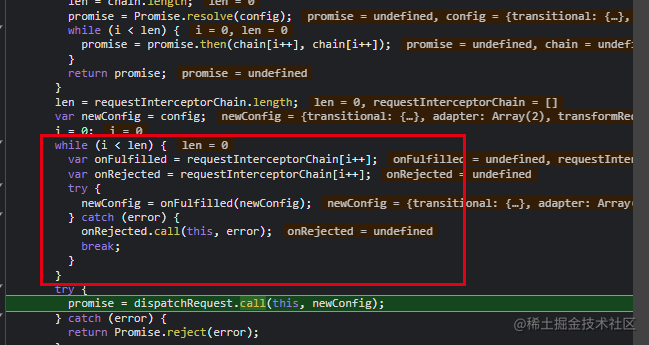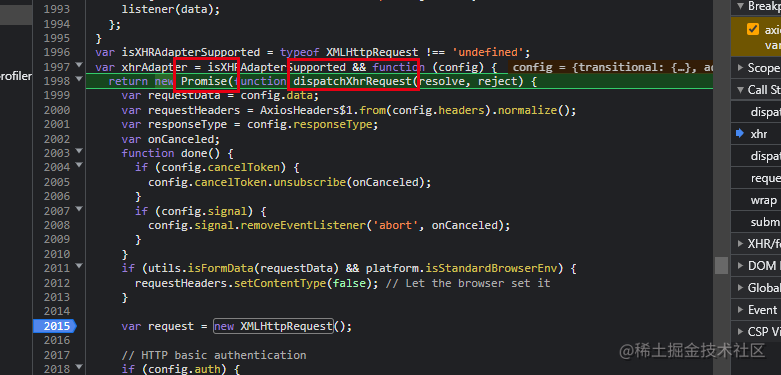源码分析
跳转至Axios.js文件中
// 构造函数constructor(instanceConfig) {this.defaults = instanceConfig// 创建对应的拦截器this.interceptors = {request: new InterceptorManager(),response: new InterceptorManager()}} 那么,拦截器是怎么创建的呢
- 首先,我们来看下拦截器的用法
- www.axios-http.cn/docs/interc…
// 添加请求拦截器axios.interceptors.request.use(function (config) {// 在发送请求之前做些什么return config;}, function (error) {// 对请求错误做些什么return Promise.reject(error);});// 添加响应拦截器axios.interceptors.response.use(function (response) {// 2xx 范围内的状态码都会触发该函数。// 对响应数据做点什么return response;}, function (error) {// 超出 2xx 范围的状态码都会触发该函数。// 对响应错误做点什么return Promise.reject(error);}); 移除拦截器,可以这样:
const myInterceptor = axios.interceptors.request.use(function () {/*...*/});axios.interceptors.request.eject(myInterceptor); 给自定义的 axios 实例添加拦截器。
const instance = axios.create();instance.interceptors.request.use(function () {/*...*/}); 可以看到,请求拦截器和响应拦截器都是使用axios.interceptors.xxx.use进行挂载
我们来看下源码实现
'use strict'import utils from './../utils.js'class InterceptorManager {// 用一个数组来存储拦截器函数constructor() {this.handlers = []}/** * 添加一个新的拦截器到栈中 * * @参数 {Function} Promise.then(fulfilled)回调函数 * @参数 {Function} Promise.reject(rejected) 回调函数 * * @return {Number} 返回ID 用来移除拦截器时使用 * */use(fulfilled, rejected, options) {this.handlers.push({fulfilled,rejected,// 是否同步synchronous: options ? options.synchronous : false,// 运行时机runWhen: options ? options.runWhen : null})return this.handlers.length - 1}eject(id) {// 如果在handlers中找到对应的id,对应的位置置为空if (this.handlers[id]) {this.handlers[id] = null}}// 重置拦截器数组clear() {if (this.handlers) {this.handlers = []}}// 遍历拦截器数组,如果当前的位置为Null,则跳过,否则执行回调函数forEach(fn) {utils.forEach(this.handlers, function forEachHandler(h) {if (h !== null) {fn(h)}})}}export default InterceptorManager 尝试调试
在全局搜索new XMLHttpRequest并打上断点,点击页面中的Send Request,进入断点
0.点击触发onClick
2.创建axios
3.调用request,检查是否有拦截器* 如果存在拦截器,则先触发
4.执行完dispatchRequest后,调用适配器
5.用Promise包裹xhrRequest
所以这个流程是
点击触发`onClick`创建axios调用`request`,检查是否有拦截器执行完`dispatchRequest`后,调用适配器用`Promise`包裹`xhrRequest` 我们来看下request是怎么实现的
request
request(configOrUrl, config) {// 检查传入的url是否是string 类型if (typeof configOrUrl === 'string') {config = config || {}config.url = configOrUrl} else {config = configOrUrl || {}}// 合并默认参数和用户定义的参数config = mergeConfig(this.defaults, config)const { transitional, paramsSerializer, headers } = config// config 对象格式化/*code...*/// 设置发送请求的方式,默认是get// Set config.methodconfig.method = (config.method ||this.defaults.method ||'get').toLowerCase()let contextHeaders// Flatten headerscontextHeaders =headers && utils.merge(headers.common, headers[config.method])// 根据传入的请求方式,构建config中的methodcontextHeaders &&utils.forEach(['delete', 'get', 'head', 'post', 'put', 'patch', 'common'],(method) => {delete headers[method]})config.headers = AxiosHeaders.concat(contextHeaders, headers)// filter out skipped interceptors// 收集所有的请求拦截器和响应拦截器const requestInterceptorChain = []let synchronousRequestInterceptors = true// 遍历请求拦截器,放到数组中this.interceptors.request.forEach()/*code...*/// 遍历响应拦截器,放到数组中const responseInterceptorChain = []this.interceptors.response.forEach()/*code...*/let promiselet i = 0let lenif (!synchronousRequestInterceptors) {const chain = [dispatchRequest.bind(this), undefined]// 将请求拦截器放到chain前面chain.unshift.apply(chain, requestInterceptorChain)// 将响应拦截器放到chain后面chain.push.apply(chain, responseInterceptorChain)len = chain.length// 生成promise实例promise = Promise.resolve(config)while (i < len) {// 将 fulfilled, rejected 取出// 链式调用promise = promise.then(chain[i++], chain[i++])}return promise}len = requestInterceptorChain.lengthlet newConfig = configi = 0while (i < len) {const onFulfilled = requestInterceptorChain[i++]const onRejected = requestInterceptorChain[i++]try {newConfig = onFulfilled(newConfig)} catch (error) {onRejected.call(this, error)break}}try {promise = dispatchRequest.call(this, newConfig)} catch (error) {return Promise.reject(error)}i = 0len = responseInterceptorChain.lengthwhile (i < len) {promise = promise.then(responseInterceptorChain[i++],responseInterceptorChain[i++])}return promise} 小结
根据上图所示,请求拦截器不断在前面unshift进去队列,响应拦截器不断在后面push进去队列,通过promise.then(chain[i++], chain[i++])的方式,从而实现Promise链式调用
dispatchRequest
这个函数处于chain队列的中间,我们来看下他做了什么事情
export default function dispatchRequest(config) {// 如果取消请求,抛出异常throwIfCancellationRequested(config)config.headers = AxiosHeaders.from(config.headers)// Transform request data// 请求的data 转换config.data = transformData.call(config, config.transformRequest)// 添加头部if (['post', 'put', 'patch'].indexOf(config.method) !== -1) {config.headers.setContentType('application/x-www-form-urlencoded', false)}// 配置适配器const adapter = adapters.getAdapter(config.adapter || defaults.adapter)return adapter(config).then(function onAdapterResolution(response) {// 取消相关throwIfCancellationRequested(config)// Transform response data// 响应数据转换response.data = transformData.call(config,config.transformResponse,response)// 处理响应的headerresponse.headers = AxiosHeaders.from(response.headers)return response},function onAdapterRejection(reason) {if (!isCancel(reason)) {throwIfCancellationRequested(config)// Transform response dataif (reason && reason.response) {reason.response.data = transformData.call(config,config.transformResponse,reason.response)reason.response.headers = AxiosHeaders.from(reason.response.headers)}}return Promise.reject(reason)})} 小结
这个函数主要做了几件事情
- 处理取消请求,抛出异常
- 处理
config.header - 根据请求的方法处理请求头
- 对请求和响应的头部和响应数据进行格式化
- 返回适配器
adapter.then处理后的Promise实例
throwIfCancellationRequested
function throwIfCancellationRequested(config) {// 文档中已不推荐使用if (config.cancelToken) {config.cancelToken.throwIfRequested()}// signal.aborted 来取消操作if (config.signal && config.signal.aborted) {// 抛出错误,外面的catch进行捕捉// return Promise.reject(reason)throw new CanceledError(null, config)}} getAdapter
接下来,就是到适配器的实现。
适配器是什么呢,适配器相当于一个转换头,出境旅游的时候,插座可能是英标,欧标等,与我们国标的插头是不一致的,国内的电器设备无法使用,这个时候需要一个**转换插头**,这个就是适配器。 // adapters.jsconst knownAdapters = {http: httpAdapter,xhr: xhrAdapter}export default {getAdapter: (adapters) => {adapters = utils.isArray(adapters) " />总结我们分析了axios的核心流程,可以知道以下几点:
- 拦截器是怎么实现链式调用并分别加载到合适的位置中
- 自定义的适配器怎么通过配置加入到
axios中 axios怎么实现取消功能- request中是怎么去收集和处理拦截器的
通过我们的深入了解,我们可以回答这些面试问题
- juejin.cn/post/684490…
0.为什么 axios 既可以当函数调用,也可以当对象使用?* axios本质上是函数,拓展了一些别名的方法,比如get(),post()等方法,本质上是调用了Axios.prototype.request函数,通过apply的形式将Axios.prototype.request赋值给axios
2.简述 axios 调用流程。* 实际上是调用Axios.prototype.request函数,内部通过Promise.then()实现链式调用,实际的请求在dispatchRequest中派发
3.有用过拦截器吗?原理是怎样的?* 拦截器通过axios.interceptors.request.use来添加请求拦截器和响应拦截器函数,先用两个数组分别收集请求拦截器和响应拦截器,然后在内部循环分别添加到两端。* 如果需要移除拦截器,可以使用eject方法移除
4.有使用axios的取消功能吗?是怎么实现的?* axios的取消功能通过config配置cancelToken(弃用)或者signal来控制,如果传入了cancelToken(弃用)或者signal,则抛出异常,使流程走到Promise.rejected
5.为什么支持浏览器中发送请求也支持node发送请求?* axios内部默认支持http,xhr请求的适配器,可以根据当前的环境去适配不同的请求,也可以自定义适配器来满足更多的场景需求。
最后
整理了一套《前端大厂面试宝典》,包含了HTML、CSS、JavaScript、HTTP、TCP协议、浏览器、VUE、React、数据结构和算法,一共201道面试题,并对每个问题作出了回答和解析。

有需要的小伙伴,可以点击文末卡片领取这份文档,无偿分享
部分文档展示:




文章篇幅有限,后面的内容就不一一展示了
有需要的小伙伴,可以点下方卡片免费领取










